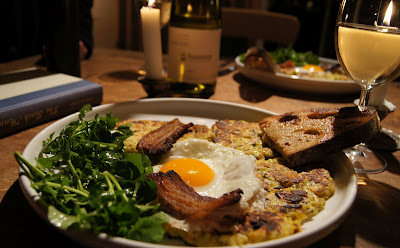My ramp explorations this spring have been taking me down Chinese roads. The oily ramp cakes started me thinking that way. For a bachelor dinner the night I whipped up those cakes I marinated some sliced pork shoulder, chopped up a mess of ramps, shredded a bit of cabbage, stir-fried it all up, sauced it with a mix of soy sauce, vinegar, rice wine, sugar, and cornstarch, served it over a bowl of rice. The ramp flavor permeated the dish utterly, and this one-off dish was one of the most Chinese tasting things I've made in a long time--and I know Chinese, having lived, taught, and traveled in Sichuan province for a total of more than a year in the late 80s-early 90s. By Chinese tasting I mean: not like Leeann Chin's.
That ramps convey a Chinese flavor is not really that surprising. Their closest domestic analog, to me, is garlic chives, sometimes called Chinese chives, and often used in Chinese sauces, dumpling fillings, and the like. In this dressing the chopped ramps are lightly charred in oil, bringing out their sweet side, along with a smoky edge. This combination of sweet, sour, salty, hot, and rampy would make your pooch's rawhide chews palatable; on blanched young nettles it's a springtime combination made in heaven...or Chengdu.
 |
| This is what I call a nettles "tip""--the top leaves with a couple inches of stem attached. Tender and delicious, once blanched, on young stinging nettles plants. |
Sub other types of salad greens for the nettles, if you like, or use the dressing on blanched green beans, fava beans, or asparagus.
Sichuan Nettles Salad with Charred Ramp Dressing
2 medium ramps, chopped to 1/4-inch pieces, about 1/3 cup
3 cups loosely packed young stinging nettle tips and leaves
1 tablespoon hot chile oil (or add 1 teaspoon of sambal chile paste and a little more oil when you cook the ramps)
1 tablespoon soy sauce
2 teaspoons cider vinegar
1 teaspoon sugar
1 1/2 tablespoons canola or peanut oil
ground roasted Sichuan pepper, optional
Rinse the nettles very well in several changes of water, especially if they were gathered from a sandy area. Bring a pot of water to a boil, add the nettles, and cook for 1 minute. Drain the nettles and shock in cold water. Drain well--save the cooking water for tea or broth, if you like--or spin in a salad spinner to remove excess water. Place the nettles in a mixing bowl.
Heat the canola or peanut oil in a small saucepan. When it is hot add the ramps and cook over high heat for 1 minute, until some of the ramp pieces look a bit charred. Remove from heat. Add the chile oil, soy sauce, vinegar, and sugar and mix well. Add this dressing to the nettles and mix well. Sprinkle with the Sichuan pepper, if you like, and serve.
Text and photos copyright 2012 by Brett Laidlaw

































